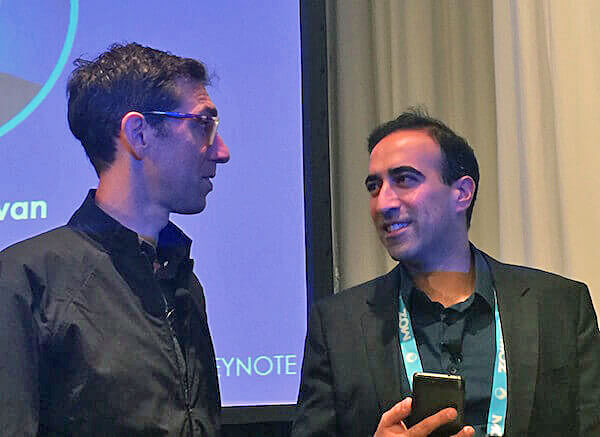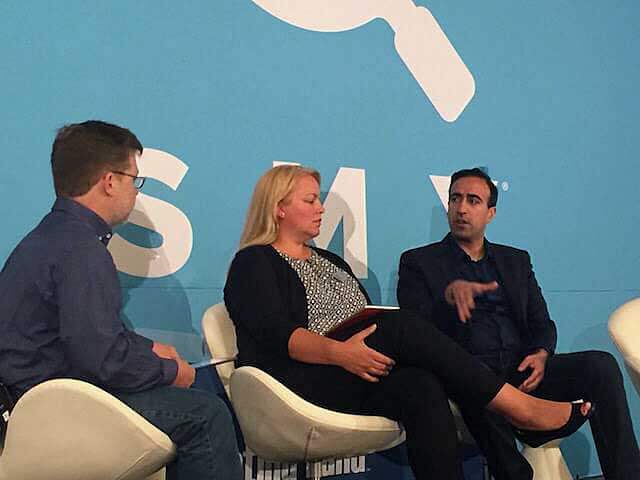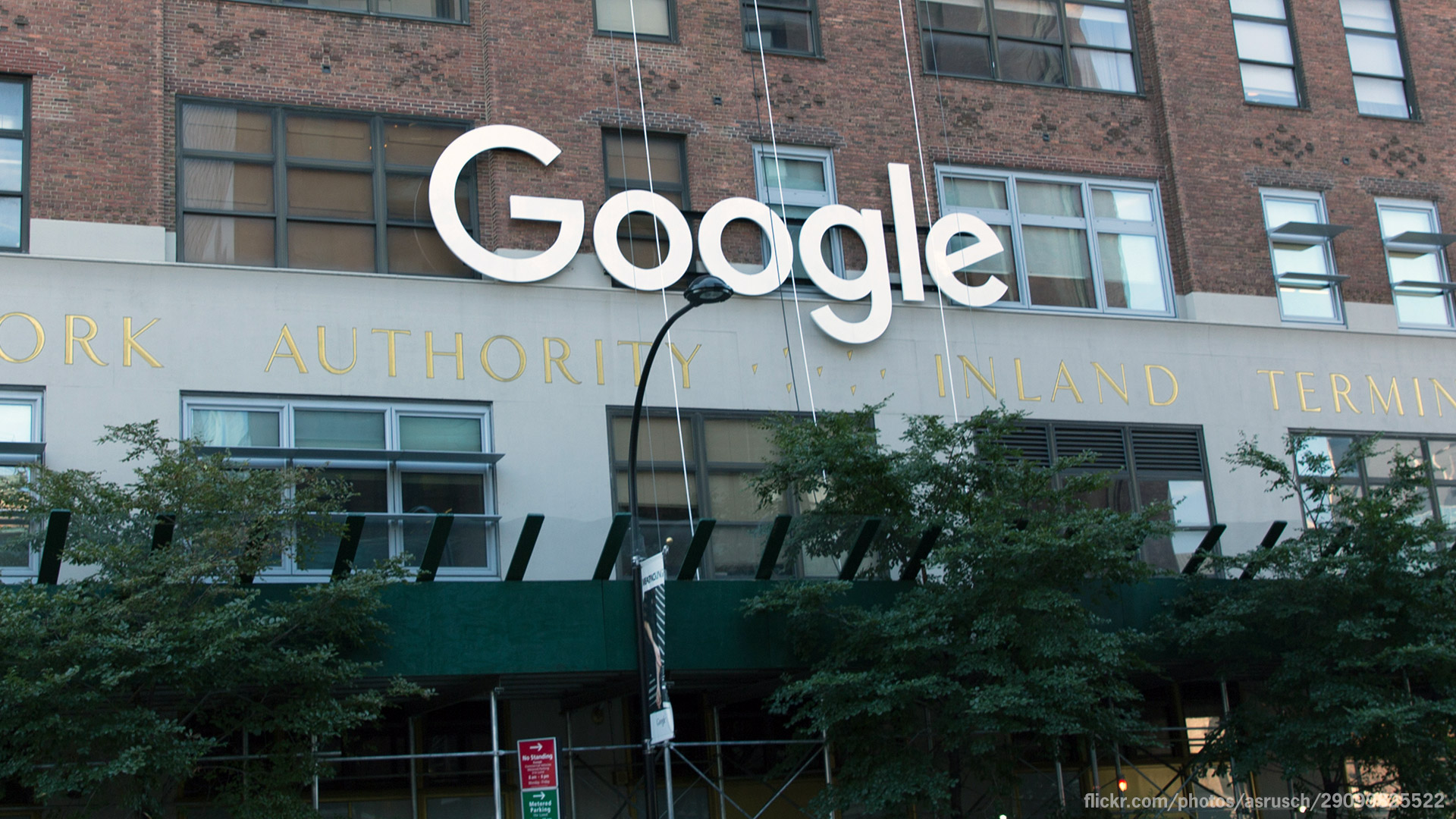What’s new and cool at Google from SMX East 2016
At this year's SMX East, Googlers Jerry Dischler and Babak Pahlavan shared recent updates and what's coming to AdWords and Google Analytics. Columnist Mark Traphagen was on hand to cover the highlights.
At this year’s SMX East conference, which took place this week in New York City, Search Engine Land reporter Ginny Marvin and contributing editor Greg Sterling hosted a conversation with Google executives Jerry Dischler, the vice president of AdWords (@jdischler) and Babak Pahlavan, the global head of products and director of Google Analytics (@babakph).
Dischler shared recent updates and changes to the Google AdWords platform, while Pahlavan covered the same for Google Analytics. Read on for highlights from their conversations.

Left: Jerry Dischler, the vice president of AdWords. Right: Babak Pahlavan, the global head of products and director of Google Analytics.
Jerry Dischler on Google AdWords updates
Expanded Text Ads
Dischler was asked why there has been a delay in the complete rollout of Expanded Test Ads (ETA), and how they are performing for those who already have access. He reported that advertisers already using ETA seem to getting good results.
Googlers tend to be optimistic, so they took on the challenge of changing the creative framework for AdWords for the first time in 15 years. However, Dischler admitted, the changeover is not happening as smoothly as they had hoped it would.
They’ve found the advertisers who are embracing ETA tend to be those who always have put great care into their optimized testing of creative, and, in general, they are seeing great results. Those who aren’t seeing results are usually just dipping their toes in the water, either not using dynamic elements or using one-size-fits-all creative. Google hopes advertisers will realize that employing the best practices they should already know will yield them more success with ETAs.
Dischler said Google has decided to wait until after the holiday season to make the switch final, so users can have more time to adjust to it.
If advertisers don’t immediately see a CTR increase from ETAs, Dischler suggests they try more and different things, using the same best practices as they always have. He encouraged them to keep testing and learning.
With non-branded, generic ETAs, there can be big differences in performance when you optimize both parts of the headline; for branded ETAs, shorter headlines work better.
Reintroduction of device bidding
In late spring of this year, Google announced it would bring back the ability to bid separately by device type (desktop vs. mobile vs. tablet). When asked why Google reversed course after dropping this capability previously, Dischler said advertisers told them they had legitimately different use cases for different devices.
For example, a traveler in New York looking for New York hotels on a mobile device is much closer to a buying decision, so it makes sense that an advertiser would want to bid higher on mobile vs. desktop. A few years ago, advertisers seemed mobile-averse, but they’ve made a dramatic shift to mobile-first, and they needed the tools to target appropriately.
What works well for device bidding is looking at current bids first from a blended point of view, then looking at performance by device and adjusting individually up or down, according to performance.
On the other hand, a demonstrated worst practice is bidding down tablets, or any other device type, without giving it due consideration. Results will differ for everyone. Look at blended first, then adjust each platform up or down.
Store visits
In this multi-device world, we should measure the entire ROI chain — online and offline. Ninety percent of retail sales still happen offline, for example, so tracking where online ads bring someone into a physical store is critical to measuring the full value of your ads.
According to Dischler, Google finds that for many advertisers, the offline benefit of ads is actually larger than the effect online. So Google has made Store Visits available to thousands of advertisers in 14 countries and is expanding their availability. The company has expanded it from search to display as well. Its desire, Dischler says, is to be able to offer a single measurement across all Google ad platforms.
One of the factors that makes Store Visits tracking work is the fact that hundreds of millions of Google users have opted in to location sharing. Google augments its data with Google Maps information, as well as input from WiFi and other signals. The company also employs human reviewers who will physically go to a location so they can tune precision. Dischler says Google is now able to pinpoint the location of a shopper with over 99-percent accuracy.

Greg Sterling, Ginny Marvin and Jerry Dischler react to an audience comment at SMX East 2016.
Audience targeting
Remarketing Lists for Search Ads (RLSA) have been a runaway success. Some advertisers are saying it’s the biggest change in the last five years for better targeting and ROI. Larger advertisers should certainly try out RLSA, Dischler suggests, adding that advertisers will be able to manage RLSA at the campaign level in the next few weeks.
Cross-device RLSA will be out this week as well, allowing targeting of users across devices.
Customer Match is designed for customers whose email address you’ve collected online or offline, allowing you to target them in search by matching those addresses to users. It also can be used to create persistent customer IDs for analytics.
Dischler also announced that Similar Audiences is now in open beta. This feature lets advertisers target their ads to audiences that are similar to the people they have on their lists. Demographics targeting is also going from open beta to release. It targets by age, gender and income.
Asked about the methodology used to pinpoint similar audiences for search, Dischler notes that Google is currently using search history but is looking to improve it with more signals. Can you layer demographics with Similar Audiences? Not yet, he said.
Local ads updates
Google recently introduced a cluster of local ad features. They’re conducting lots of experiments, but the features are not yet broadly available. They’re exploring how to make online ads drive even more traffic to physical stores, with things like Promoted Pins on apps and multiple new ad formats.
They’re putting lots of investment into this area. Local inventory ads are now more established. Best Buy drove over one million incremental store visits with them the last holiday season.
As for ads in the Local Pack in Search, there are currently two different iterations, one in experiment and the other launched. The launched type shows up when a user expands from the Pack to a full list; the experimental type shows up before expansion.
Babak Pahlavan on Google Analytics updates
Google Data Studio
Google Data Studio, a free version of Google Data Studio 360, is a dashboarding and reporting tool launched earlier this year. You can be up and running and reporting quickly by just connecting to data sources, instead of exporting first. Google has been focusing on a second notion of collaboration and sharing. The aim is to easily share reports in an organization, with the ability to collaborate on the information.
Google launched 360 Enterprise and the free version for US users earlier this year. Data Studio is now rolling out, not only to the US, but also to a number of other countries.

Greg Sterling and Ginny Marvin talked to Babak Pahlavan onstage at SMX East.
Google Optimize free version
Pahlavan said more free tools are coming. Optimize 360 Enterprise was announced earlier this year, but the objective is to improve measurement for all size users.
Pahlavan announced a free version of Optimize at SMX East that will be available later this year. To get on the waiting list for it, go to G.co/optimize. It natively integrates into Google Analytics, and works right out of the box. Conversions and goals are easily brought into Optimize.
Motley Fool said they went from days to minutes for the same analysis by implementing Optimize 360. A major gold and silver coin retailer was able to double their per-user revenue by using data from it to tailor on-site experiences for users.
Smart Goals
Smart Goals are for advertisers who have not set up their own goals. It uses machine learning to give them more potential conversion information.
SG is helpful for ecommerce sites that don’t have much transaction data. It automatically sets up goals for them. Users actually get a preview of what performance could look like with a certain optimization.
Pahlavan also announced a new session quality score that exposes more of the data from Smart Goals. The score shows a likelihood of conversion for a session, allowing you to optimize that user’s experiences and/or create targeted remarketing for them.
Autotracking
Autotrack library is a collection of plugins that shortcut complex setups. Designed for the developer community, they ended up becoming wildly popular. But Pahlavan sill advises more advanced customers to use Google Tag Manager. Another 20 tags are being announced for Tag Manager.
He was asked: “If you already have your own custom HTML tag for a tracking purpose, should you drop it for a plugin?” Google recommends all customers switch to Tag Manager as soon as possible, as it gives more control and customization.
Mobile app insight cards
Insight cards in the Google Analytics mobile app leverage machine learning. They eventually will be available on desktop Analytics as well.
Insights automatically analyzes your signals to call out trends you might want to know about. Google tests it with their own site that sells Google souvenirs to Googlers. Pahalvan shared that he got alerted to a site speed concern with the test site’s Indian servers that they might not have noticed for weeks on their own.
Insights doesn’t use pre-defined benchmarks; it continually learns from your own data to call out what is truly interesting but previously might have been hidden in your data.
Further insights from the audience Q&A
AdWords
- Extended Test Ads are being tested in a lot of new ad formats.
- Why did they restrict Keyword Planner data from users without active AdWords campaigns? Dischler answered they wanted “good actors” using it while keeping out “bad actors.” He said the spend limits are low, so most account holders should be able to still get data, as well as agencies representing advertisers in most cases.
- There are no plans to extend Store Visits for channels outside paid search, other than the expansion to Display.
Analytics
- Data Studio data sources will continue to expand the sources you can connect to. In October, Google will roll out templates for reports for data visualization. Five reports per account for now, but they are analyzing where more demand may exist.
- What about creating remarketing in AdWords vs. Analytics? Is one better than the other? You can use your Google Analytics lists in AdWords; they are complementary.
- There are no plans to add more ad slots in Google Search. They have to look at the space available to both expanded ads and organic results on a query-by-query basis according to intent.
- What is Google doing about Analytics referrer spam? Dischler said they have an active project in the works to combat such spam. They don’t share stats externally, but they do take spam seriously.
Opinions expressed in this article are those of the guest author and not necessarily MarTech. Staff authors are listed here.
Related stories


